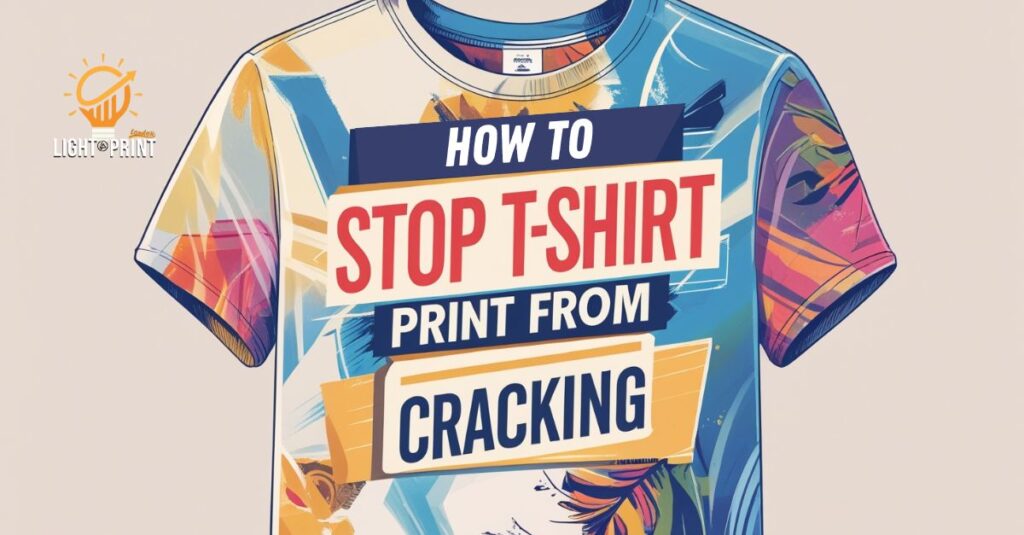
Custom t shirts are a great way to show off your style, promote a brand, or create special gifts. At Light Print, located in London, we specialize in providing high-quality, long-lasting prints that won’t crack. But nothing is more frustrating than seeing your favorite design crack, peel, or fade too soon. A cracked print can make a shirt look old and worn out, even if it’s still new. The good news? You can stop t shirt print from cracking with the right materials, printing methods, and care.
In this guide, we’ll share 7 simple ways to keep your prints looking fresh. We’ll also explain why prints crack, how to pick the right fabric, and how to wash your t-shirts the right way. Let’s get started.
Discover the 6 Most Common Causes of T Shirt Print Cracking
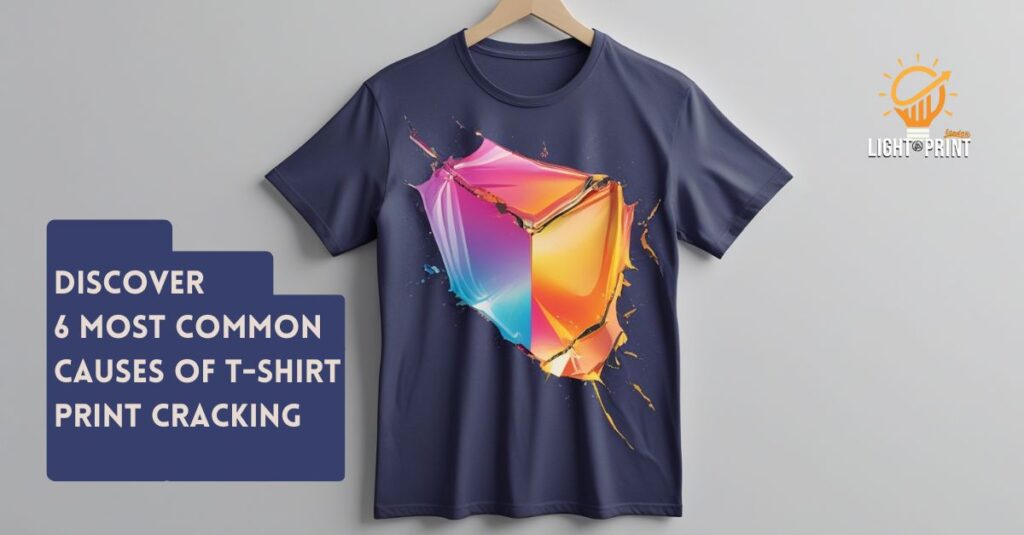
Before learning how to stop t shirt print cracking, it’s important to know why it happens. Cracking doesn’t occur overnight, it results from avoidable mistakes. Below are the top reasons your prints may crack over time.
Low Quality Ink and Materials: A Leading Cause of T Shirt Print Cracking
Not all printing materials are the same. If you use cheap ink or low quality heat transfer vinyl (HTV), your print won’t last long. Over time, these materials wear out quickly and start to crack. That’s why choosing premium ink and high-quality materials is the first step to a durable design.
Improper Curing: Why Heat Matters
Curing is the process of applying heat to set the ink or vinyl onto the fabric. Without proper curing, the print stays weak and cracks sooner than expected. To avoid this, always follow the manufacturer’s recommended temperature and curing time. For example, screen-printed designs usually require 320°F (160°C) for 60 seconds to cure properly.
How Incorrect Washing Can Cause T Shirt Prints to Crack
Did you know that washing t shirts incorrectly can shorten their lifespan? When you wash your t-shirt in hot water or dry it on high heat, the ink becomes weak and brittle. As a result, the print starts to crack. To extend its life, always wash in cold water and air dry instead of using a high heat dryer.
Stretching the Fabric: How Wear Affects the Print
Every time you stretch a t shirt, the print stretches too. Unfortunately, this puts stress on the design and leads to cracking over time. For this reason, choosing stretch-friendly fabrics or wearing a relaxed-fit t shirt can help prevent unnecessary tension.
Sun Exposure: The Silent Fade
Leaving your t shirt in the sun for too long can be harmful. Over time, direct sunlight fades the ink and weakens the fabric. Because of this, prints may become brittle and prone to cracking. To prevent this, store t-shirts in a cool, shaded area and avoid drying them under direct sunlight.
Fabric Type Matters: Best Fabrics to Stop T Shirt Print from Cracking
Not all fabrics hold prints equally well. If you want a long lasting print, selecting the right material is just as important as using high quality ink.
- 100% Cotton – Great for screen printing and direct-to-garment (DTG) printing.
- Cotton-Polyester Blends – Works well for heat transfer vinyl (HTV) and sublimation printing.
- Nylon or Silk – These materials don’t absorb ink well, making them prone to cracking.
Fabric choice is important for print durability. To avoid cracking, always choose good quality fabric and the right printing method. At Light Print London, we use top materials and expert printing. This helps your prints last longer and stay smooth.
6 Proven Preventive Measures to Stop T Shirt Print from Cracking
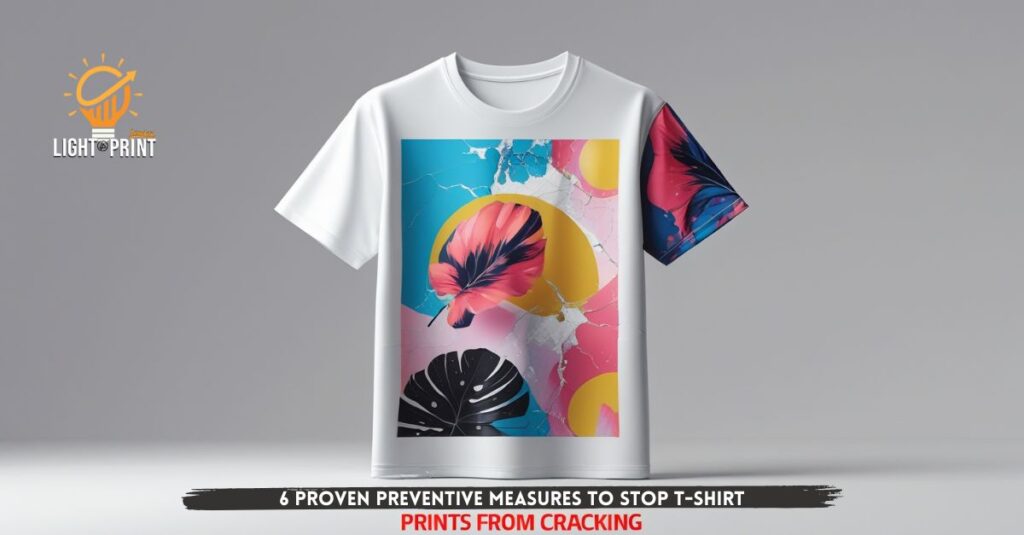
Now that we know why t-shirt prints crack, let’s explore the best ways to stop t shirt print from cracking. Here are six expert tips to ensure your t-shirt prints last longer.
Use Premium Quality Inks and Materials for a Stronger Print
The quality of the ink or heat transfer vinyl (HTV) plays a major role in durability. Cheap materials don’t bond well with fabric, leading to cracking and peeling over time. Screen printing works best with plastisol or water-based ink for durability. For HTV, high-quality vinyl brands like Siser or Cricut last longer. DTG printing should use pigment-based ink for better fabric penetration and flexibility.
Perfect the Curing Process to Set the Print Properly
Curing ensures the ink or vinyl bonds permanently to the fabric. Without proper curing, prints crack and peel quickly. Screen printing requires a conveyor dryer or heat press at 320°F (160°C) for plastisol ink. HTV should be pressed at 305°F (150°C) with medium pressure. DTG prints need a curing oven or heat press at 330°F (165°C) for better durability. Always use a temperature gun to ensure even heat distribution.
Choose the Right Printing Method for Maximum Print Longevity
Not all printing methods are equally durable. Screen printing is the most long-lasting and great for bulk orders. DTG printing works well for detailed designs but requires proper curing. HTV is ideal for custom prints but can crack if low-quality vinyl is used. Sublimation printing is long-lasting but works only on polyester. If durability is your priority, screen printing is the best choice.
Use the Right Amount of Ink to Prevent Overloading
Applying too much ink makes the print thick and brittle, leading to cracking. Following the correct ink-to-fabric ratio helps prevent this. Overloading ink in DTG printing can cause poor adhesion, so applying a pre-treatment solution can improve durability. For screen printing, avoid double printing unless necessary. Always test a sample before mass production to check ink thickness.
Pre-Wash the Fabric to Reduce Shrinkage and Tension
Some fabrics shrink after the first wash, which can put stress on the print and cause cracks. Pre-washing removes coatings that affect ink bonding and minimizes post-print shrinkage. This is especially important for cotton and cotton-polyester blends. Using pre-shrunk fabric improves print durability and keeps the design intact.
Avoid Overstretching the Fabric During Printing
Stretching the fabric while applying ink or vinyl can cause cracks when the material relaxes. Keep the fabric flat and stable during printing. Using a proper platen helps prevent movement in DTG and screen printing. For HTV, avoid excessive pressure during application. Let the fabric cool naturally after printing to maintain print integrity.
7 Essential T Shirt Print Care Tips to Extend Lifespan
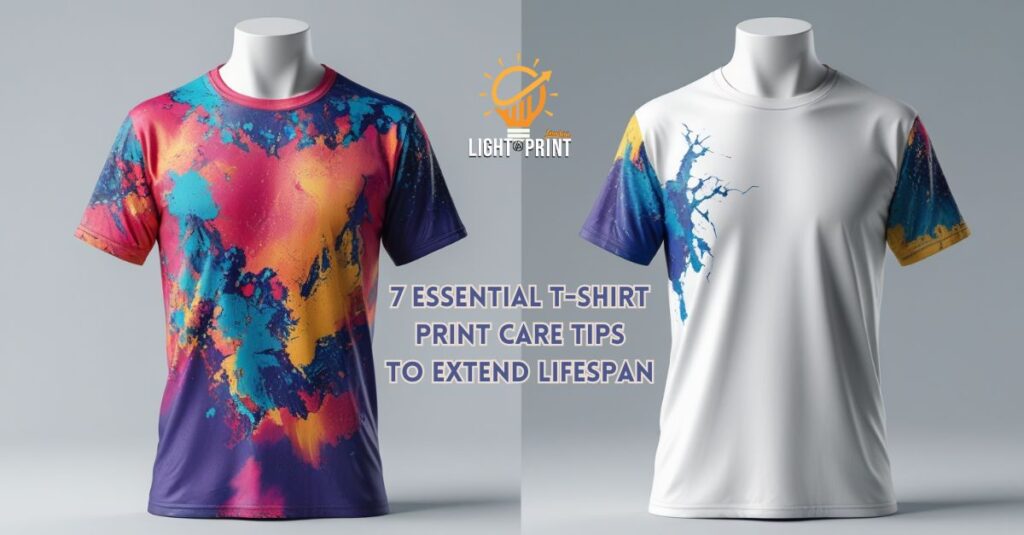
Even high quality print can crack over time. Follow these seven essential care tips to stop t shirt print from cracking and extend the life of your design.
Wash Inside Out to Reduce Friction and Protect the Print
Turning your t shirt inside out before washing prevents the print from rubbing against other clothes or the washing machine drum. This reduces wear and tear and keeps the design intact.
Wash in Cold Water with Gentle Detergents
Hot water can weaken ink and vinyl, leading to cracks. Instead:
- Use cold water to preserve the print.
- Choose gentle detergents free from harsh chemicals.
Air Dry for the Best Results (Avoid High Heat Dryers)
High temperatures can damage the ink and shrink the fabric, leading to cracks. The best drying method is:
- Air drying – Lay the shirt flat or hang it.
- Low heat drying – If using a dryer, set it to low heat or tumble dry.
Store T Shirt Properly to Prevent Creasing and Stretching
How you store your shirts matters. Avoid leaving them in tight stacks or hanging them on thin wire hangers, which can cause stretching.
- Fold them neatly and store in a cool, dry place.
- Use padded hangers if hanging them.
Avoid Harsh Chemicals Like Bleach and Fabric Softeners
Bleach and fabric softeners weaken the ink and vinyl, making prints crack faster. Instead:
- Skip the bleach.
- Avoid fabric softeners.
- Use mild detergents designed for printed fabrics.
Use a Protective Cloth When Ironing Over Prints
Direct heat from an iron can melt or damage the print. To prevent this:
- Place a thin cloth or parchment paper over the print.
- Use a low heat setting when ironing.
Don’t Overcrowd Your Closet: Give Shirts Room to Breathe
When storing shirts, overcrowding can cause folding stress on prints, leading to premature cracking. Give your t shirts space to breathe by not stacking them too tightly.
Conclusion: Key Takeaways to Stop T Shirt Print from Cracking
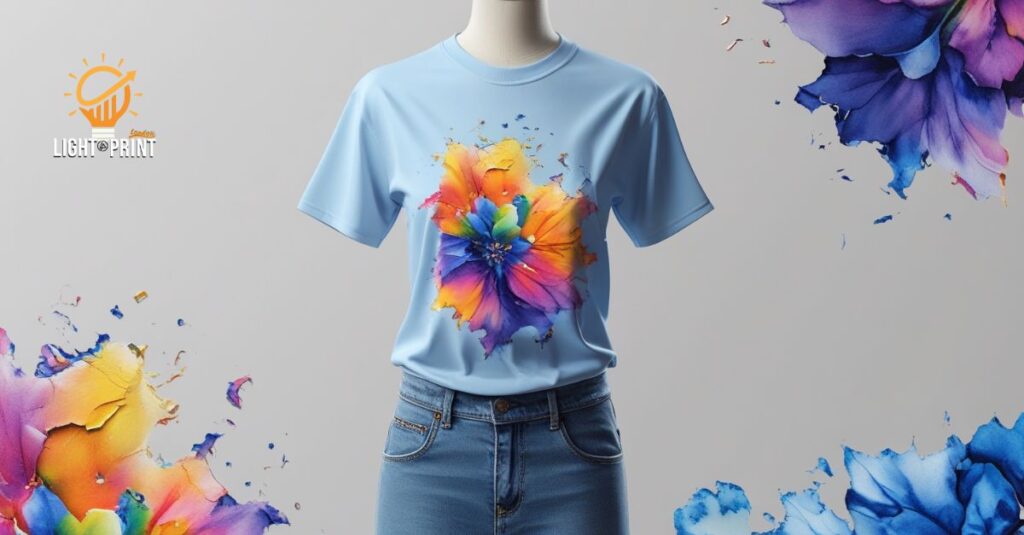
T shirt print cracking is frustrating, but it’s preventable with the right approach. By understanding the causes, choosing the best printing methods and materials, and following proper care steps, you can enjoy prints that last for years.
First, quality materials matter. Always use premium inks, HTV, or fabrics for the best results. Next, proper curing is essential. Be sure to follow the right heat settings and curing times. When washing, always wash with care. Use cold water and air dry your shirts to preserve both the print and fabric. Also, store your shirts properly. Avoid overcrowding and keep them in a cool, dry place. Finally, avoid harsh chemicals like bleach and fabric softeners, as they weaken the print.
By following these steps, you can stop t-shirt print from cracking and keep your custom t-shirts looking fresh for a long time. If you want t-shirts with durable prints, Light Print London in Stepney Green, London is here to help. Contact us today for custom t shirt print.
FAQs on How to Stop T Shirt Print from Cracking and Fading

To help you keep your t shirt print looking fresh, here are answers to some frequently asked questions about print cracking and how to prevent it.
How Long Should T Shirt Print Last?
With proper care, t shirt prints can last for years. High-quality materials and correct washing techniques are key. If you follow the tips in this guide, your print will stay vibrant for a long time.
Can I Fix a Cracked T Shirt Print?
In some cases, you can restore minor cracks. You can reheat the design with a heat press or iron. However, if the print is badly cracked or peeling, it’s hard to fix. The best option is to prevent cracking before it happens.
Is Screen Printing Better Than Heat Transfer Vinyl (HTV)?
Yes, screen printing is the better option for long-lasting durability. It bonds strongly with the fabric and is less likely to crack. However, HTV can also work well for custom designs. Just make sure to use high-quality vinyl and follow the right pressing techniques.
Can I Wash Printed T Shirt in Hot Water?
No, washing printed t-shirts in hot water can damage the print. It can cause it to crack and fade faster. Always wash printed shirts in cold water to protect the design.
Does Fabric Type Affect Print Cracking?
Yes, fabric type plays a big role. 100% cotton and cotton-poly blends are the best choices. Synthetic fabrics like polyester can cause ink to crack or peel more quickly.
Can I Use a Dryer for Printed T Shirt?
It’s best to air-dry printed t-shirts whenever possible. High heat from dryers can cause print to shrink or crack. If you must use a dryer, set it to low heat or use the tumble dry setting.
Do Fabric Softeners or Bleach Damage Printed Design?
Yes, fabric softeners and bleach can weaken the print. This makes it more likely to crack or fade. Stick to mild detergents and avoid bleach for the best results.
Why Do Some T Shirt Print Crack Faster Than Others?
Some t shirt print crack faster because of:
- Low-quality ink, vinyl, or transfer paper
- Incorrect heat pressing or curing
- Washing in hot water or drying on high heat
- Poor fabric choice, like low-quality polyester blends
To keep your prints looking fresh, always choose quality materials and follow proper washing instructions.





